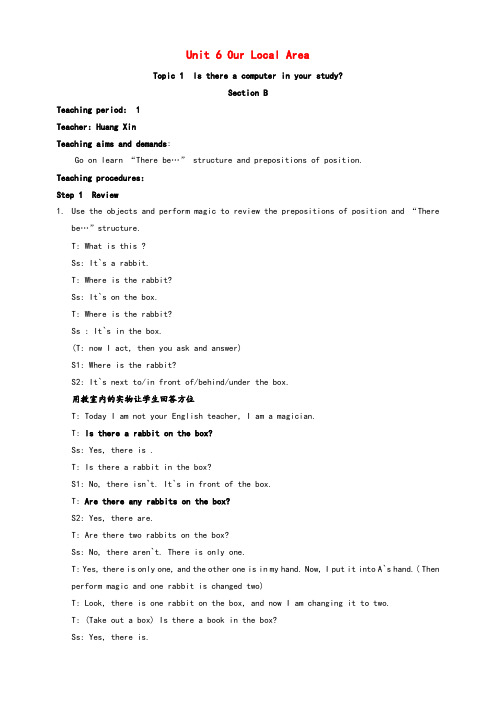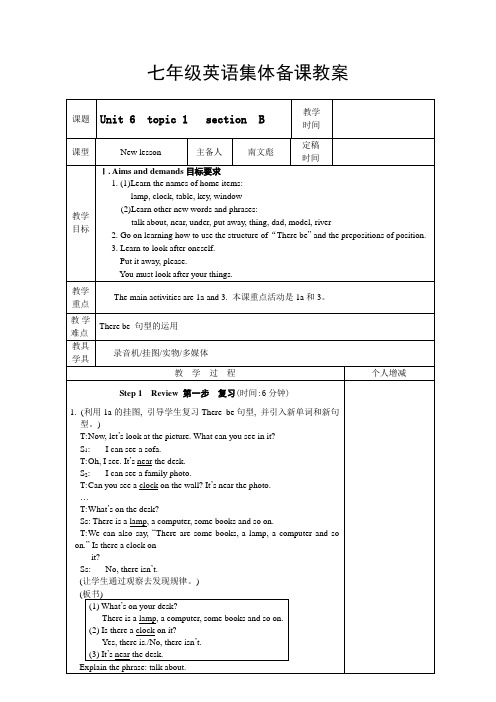【公开课教案】仁爱英语七年级下Unit 6 Topic1 SectionB 教学设计
- 格式:doc
- 大小:25.50 KB
- 文档页数:5


仁爱版英语七年级下册Unit 6 topic 1 section B 教学设计一. 教材分析仁爱版英语七年级下册Unit 6 topic 1 section B主要介绍了日常生活中的疾病和健康饮食。
通过本节课的学习,学生能够掌握关于疾病和健康饮食的词汇和句型,并能够运用所学知识进行简单的交流。
本节课的内容与学生的日常生活紧密相连,有利于激发学生的学习兴趣和积极性。
二. 学情分析七年级的学生已经掌握了一定的英语基础知识,具备一定的听、说、读、写的能力。
但是,学生的英语水平参差不齐,部分学生对英语学习缺乏兴趣。
因此,在教学过程中,教师需要关注学生的个体差异,激发学生的学习兴趣,提高学生的英语水平。
三. 教学目标1.知识目标:学生能够掌握关于疾病和健康饮食的词汇和句型,理解课文内容。
2.能力目标:学生能够运用所学知识进行日常交流,提高听、说、读、写的能力。
3.情感目标:学生能够关注自己的健康状况,养成良好的生活习惯。
四. 教学重难点1.重点:学生能够掌握关于疾病和健康饮食的词汇和句型,理解课文内容。
2.难点:学生能够运用所学知识进行日常交流,提高听、说、读、写的能力。
五. 教学方法1.任务型教学法:通过设定各种真实的任务,引导学生参与课堂活动,提高学生的学习兴趣和积极性。
2.情境教学法:创设各种情境,让学生在实际情境中运用所学知识,提高学生的实际应用能力。
3.小组合作学习:鼓励学生分组讨论和合作完成任务,培养学生的团队合作意识和沟通能力。
六. 教学准备1.教材:仁爱版英语七年级下册。
2.多媒体设备:电脑、投影仪、音响等。
3.教学资源:病句卡片、健康饮食图片等。
七. 教学过程1.导入(5分钟)教师通过向学生提问:“你们知道哪些疾病?你们平时是如何注意健康的?”引导学生谈论疾病和健康饮食,激发学生的学习兴趣。
2.呈现(5分钟)教师通过课件展示本节课的主要词汇和句型,如“I have a cold.”、“I have a stomachache.”等,并引导学生跟读。

阜南县三塔中学英语组公开课课例设计课题:仁爱七下Unit 6 Topic 1 Section B仁爱七下Unit 6 Topic 1 Section BStep 1 Review 第一步复习(时间:10分钟)1.(此活动的目的是复习"there be"。
在黑板上呈现一张漂亮的图,图的内容是一栋两层的楼,有书房、卧室、厨房、餐厅、客厅、卫生间、花园。
)T: Look at the picture for one minute.Then I'll take it away.You'll say as many sentences as possible about it in two mintues.The winner has the most sentences.(然后把图拿走,要求学生凭着记忆,描述这张图,可以采用竞赛的形式,可以分组竞赛,也可以面对全班以个人为单位竞赛激发学生的学习热情。
)竞赛规则如下:(参赛人只能在规定的两分钟内描述这张图,说对一句,得一分,谁说对的句子多,谁就获胜。
)Example:There's a study on the second floor.There's a garden in front of the house.There are some flowers in the garden.The living room is next to the dining room.2.(利用1a 的挂图,引导学生复习there be ,并引出there be 的复杂形式。
)T: What can you see in the picture?S 1: I can see a sofa.S 2: I can see a family photo and a clock.S 3: I can see a lamp , a computer and some books.S 4: I can see a desk and a chair.T: What's on the wall?Ss: There's a clock and a family photo.(指导学生回答。

初中仁爱七年级英语下册Unit6 Topic1 Section B 教学设计课题:Unit 6 Topic 1 Section B 课型:听说课本课主题属于“人与自我”主题范畴中的“身边的事物与环境”子主题内容,部分涉及子主题学习和生活的自我管理。
一.课本研读What:本课围绕着物品的位置,学习方位介词和介词短语,以及there be句型。
是一篇听说课,通过听和说操练学生对于方位介词和短语的认知和掌握,听对话,完成任务来学习there be句型,重点在于学习there be句型的使用规则。
Why:本课引入冬奥会内容,树立学生荣誉感,增加了学习趣味,培养了学生爱国意识,使学生在学习英语的同时,了解时事,加入了爱国主义情感教育。
其中有一个环节,让学生自己设计自己的梦想之屋,这一环节培养了学生自主创新意识,表现了学生对于生活的热情,对未来的向往。
How:教学内容主要是方位介词及短语,以及there be句型。
开始我设计通过动画和实物来复习方位介词以及引出新的方位介词。
接下来用动画和图片反复操练方位介词。
让学生不光从抽象和具体中感受感知方位介词的意思和用法。
在教授there be句型时,用体育明星来激起学生兴趣,深入感知“就近一致”原则。
由通过听对话,布置任务,从听,说,读,写各个方面加深对此句型的理解掌握。
核心任务体现在以读促写,从输入到输出的过程。
注意在以读促写过程中,需要老师根据学生学习情况进行分层教学指导。
学情分析:本课为听说课,侧重学生听说能力培养。
七年级的学生词汇量比较少,很多不敢张口说,怕出错。
老师应该鼓励学生大胆开口,认真听勇敢说,这样才能为将来的学习打好基础。
学习反思:我上的这节课主要是学习there be句型以及方位介词:in front of,in the front of,near等方位介词词组的用法。
掌握这些短语和句型并不难,但对于基础薄弱的学生来说,如何让他们学得更轻松,更扎实就成为我这节课课堂设计的一个重点。

Unit 6 Our Local AreaTopic 1 Is there a computer in your study?Section BTeaching period: 1Teacher: Huang XinTeaching aims and demands:Go on learn “There be…” structure and prepositions of position.Teaching procedures:Step 1 Reviewe the objects and perform magic to review the prepositions of position and “Therebe…”structure.T: What is this ?Ss: It`s a rabbit.T: Where is the rabbit?Ss: It`s on the box.T: Where is the rabbit?Ss : It`s in the box.(T: now I act, then you ask and answer)S1: Where is the rabbit?S2: It`s next to/in front of/behind/under the box.用教室内的实物让学生回答方位T: Today I am not your English teacher, I am a magician.T: Is there a rabbit on the box?Ss: Yes, there is .T: Is there a rabbit in the box?S1: No, there isn`t. It`s in front of the box.T: Are there any rabbits on the box?S2: Yes, there are.T: Are there two rabbits on the box?Ss: No, there aren`t. There is only one.T: Yes, there is only one, and the other one is in my hand. Now, I put it into A`s hand.( Then perform magic and one rabbit is changed two)T: Look, there is one rabbit on the box, and now I am changing it to two.T: (Take out a box) Is there a book in the box?Ss: Yes, there is.T: Is there a cup in the box?Ss: No, there isn`t. There is a book.T: Are there any cups in the box?S3: Yes, there are.T: Are there any rabbits in the box?Ss: No, there aren`t.T: Right. There is nothing in the box. Nothing , really? Oh,no, there is a small box in it. And in the a small box there are two flowers.( Take out three small boxes from the big boxes by performing magic把句型跟学生进行解释(these are the sentences we have learned yesterday. Pay attention to singular number and even numbers. Now read after me)Step 2 Presentation1.Show a plan of an apartment on the screen.T: Look. Here is my new apartment. What’s in it?Ss: There is a bathroom, a dinning room, a kitchen, a living room, a study, a garden and two bed rooms.T: Right, now guess “What’s in my study?”Ss: Is there a …? / Are there any…?2.T: Great, look! Here is my study. Can you tell me what is on the table?Ss: There is a clock.T: And…Ss: There are some books.板书并告诉学生无论单数还是复数都是用what`s 来问,但是单数就用there is 来回答,复数用there are 来回答。

七年级英语集体备课教案板书设计教学反思随堂练习单项选择( ) 1.—Where are my keys, Dad? I can’t find them.—Look! They’re under the table. You must _____ .A.put it awayB.put away itC.put them awayD.put away them( ) 2.Excuse me, can you tell me _____ Xinhua Bookstore?A.the way toB.the wayC.the road toD.the road( ) 3.—Excuse me, may I speak to Linda?—_____A.Sorry, I don’t know you.B.Who are you?C.Is that Linda?D.This is Linda speaking.( ) 4.—Excuse me, _____ is it from here to Zhongshan Park?—It’s about seven kilometers.A.how longB.how oftenC.how farD.how much( ) 5.Listen, one of the _____ singing in Japanese.A.girl isB.girls areC.girl areD.girls is巩固练习根据对话的情景,从方框中选择适当的句子填在画线处,使对话完整通顺。
其中有两项是多余的。
A: Excuse me. 21B: Go down this street, turn right and walk on until you get to the end.22 It’s between the post office and the food shop.A: 23B: It’s about seven kilometers from here.24A: Which bus do I need to take?B: First, you need to take bus No. 651, then you should change to the No.426 bus at Yongding Bridge. 25A: Thank you very much.B: You are welcome!。
仁爱版英语七年级下册Unit 6 topic 1 section B 教案一. 教材分析本节课是仁爱版英语七年级下册Unit 6 topic 1 section B。
本节课主要讲述了在公园的场景,通过对话展示了如何询问和描述公园里的设施和活动。
本节课的主要语言点是询问和描述公园里的设施和活动,以及如何表达喜好。
二. 学情分析七年级的学生已经掌握了一些基本的英语语法和词汇,但他们的口语表达能力和听力还有待提高。
此外,他们对公园这个主题可能比较熟悉,但如何用英语描述公园里的设施和活动可能还需要引导。
三. 教学目标1.能够听懂、说出一系列描述公园设施和活动的词汇和句型。
2.能够通过对话询问和描述公园里的设施和活动。
3.能够用英语表达自己对公园活动的喜好。
四. 教学重难点1.重点:掌握描述公园设施和活动的词汇和句型。
2.难点:如何用英语表达自己对公园活动的喜好。
五. 教学方法1.任务型教学法:通过完成各种任务,让学生在实际语境中运用所学知识。
2.交际法:通过模拟公园场景,让学生在实际交际中提高口语表达能力。
六. 教学准备1.教学课件:制作包含公园场景的课件,展示相关词汇和句型。
2.公园地图:准备一张公园地图,用于引导学生描述公园里的设施和活动。
3.录音机和磁带:准备录音机和磁带,播放对话录音。
七. 教学过程1.导入(5分钟)利用课件展示公园的美景,引导学生谈论他们对公园的喜好。
例如:“Do you like parks? Why?”2.呈现(10分钟)展示公园地图,引导学生观察公园里的设施和活动。
然后,展示对话录音,让学生听懂对话内容。
3.操练(15分钟)学生分组,模拟公园场景,用英语进行对话。
教师巡回指导,纠正学生的错误,并给予鼓励。
4.巩固(5分钟)教师选取几组学生的对话,进行展示和评价。
同时,引导学生用英语描述自己喜欢的公园活动。
5.拓展(5分钟)邀请学生分享他们去公园的经历,用英语描述公园里的设施和活动。
Unit6 Topic1 SectionB优质课教案Ⅰ. Teaching aims1. Knowledge aims:1) Words and phrases: lamp, clock, near, under, chair, behind, front, guitar, window, table, key, put away, door, look after, thing.2) Sentences:—Is there a computer in your study?—Yes, there is. / No, there isn’t.—Are there any English books in your study?—主语+ work / works + 地点.Please put them away.Don’t put them there.2. Skill aims: Can talk about the position with the position prepositions.3. Emotional aims: Cultivate students to observe the surroundings.II. The key points and difficult points1. The general question of “there be……” structure.2. The position prepositions.III. Teaching methodsspeaking and practicing and listeningIV. Teaching toolmulti-mediaV. Teaching timeone periodVI. Teaching proceduresStep1 Lead-in1. Greeting.2. Play a guessing game. Show pictures to guess “What’s in the bag?” and “What’s on the wall?”. The students can use the following sentences.Ss: Is there …?T: Yes, there is. / No, there isn’t. (Lead students to learn other position prepositions.)Step2 Presentation1. Show some pictures to learn “next to”“under”“near”“at the back of ”“behind”“in the front of ”“in front of”. We can use the following structures.1) —What’s next to the sofa?—There is a lamp next to the sofa.2) —Is there a cat on a sofa?—No, there isn’t.3) —Where is the woman?—She is in the front of the car.2. Ask and answer. Show some key words and some pictures. Ask students to make conversations according to them. And then read them out.Step3 Consolidation1. Ask students to say out the position prepositions quickly according to the pictures.2. Show the position preposition in Chinese or English, then ask students to say out them in English or Chinese. The teacher asks them to make a phrase at the same time. Step4 Practice1. Look at the pictures in Part 3 and ask students to finish the two dialogs. Then listen to the dialog to check the answers.2. Show the picture in 1a, then the teacher introduces it. Lead to 1a.3. Listen to 1a and finish the table.4. Read 1a loudly.Step5 Summary1. Sum up the key points we learn today.2. Play a game. The teacher prepares some paper which some key words are written on. Ask one student to choose one. He should make a sentence or finish some sentences as required.Step6 Homework1. Finish the workbook.2. Try to use the position prepositions we learn today to describe your home or some places.板书设计Unit 6 Topic 1 Our Local Area Section B 1. in on under next to near at the back of behindin front of in the front of2. —Is there …?—Yes, there is. / No, there isn’t.3. —Are there …?—Yes, there are. / No, there aren’t.4. Don’t put t hem there.5. Put them away, please.。
仁爱英语七年级下Unit 6 Topic1 Section B 教学设计
一、Teaching aims
1. Knowledge aims
(1)继续学习“There is /are”表示“存在有”这一句型。
(2)继续学习并能正确使用方位介词或介词短语,如:on, in, in front of, behind, near, under等;
(3)掌握单词lamp, clock, table, chair, key, window, guitar, 并学会保管好自己的物品。
(4)能够就“存在、请求、命令”等交际功能的基本法进行交流和对话操练,如:
(1)—Is there a student in front of the classroom?
—No, there isn’t.
(2)Put it/them away, please.
(3)You must look after your things.
2.Skill aims
(1)能识别出不同的语调,如陈述句和疑问句等;
(2)能听懂谈论房间、室内摆设的表达,并做出恰当回应;(3)能就房间、室内摆设进行简单的交流;
(4)能在口头表达中做到发音清晰,语音语调准确;
(5)能正确朗读对话,注意语音语调和单词重音;
(6)能理解并执行简单的书面指令;
(7) 能准确写出黑体单词和词组。
3.Emotional aims
(1)能在学习的同时,热爱自己的生活环境;
(2)能够与同伴积极合作,参与课堂活动,大胆实践。
二. The key points and difficult points
1.Key points:
(1) “There is /are”表示“存在有”句型.
(2) 方位介词或介词短语,如:on, in, in front of, behind, near, under
等;
2. Difficult points:
(1)方位介词或介词短语,如:on, in, in front of, behind, near, under 等使用。
三. Learning strategies
1.能与他人合作,共同完成学习任务;
2.能够在英语学习中积极思考;
3.能够运用图片、关键词、实物等进行听前预测。
四. Teaching aids:multimedia teaching
五.Teaching Method : the Task-based Language Teaching Method 六.Teaching procedures
Step1Review
1.Look at the pictures and say out the words of Section A.
2.Say out the phrases according to Chinese meanings.
3.Ask and answer.
Step2Presentation
1.Look at the pictures and say out the new words, then make sentences
with there be.
2.Describe the picture with there be.
3.Ask and answer according to the pictures.
Step3Consolidation
1.Look at the following two pictures and read the conversations
below them.
2.Ask and answer questions about the following two pictures. Then
explain key points.
3.Listen to 1a and mark T (True) or F (False) in 1b.
4.Read 1a and answer the following questions.
5.Read 1a again and find out the phrases and the sentences with
there be .
6.Listen to 1a again and follow.
Step4Practice
1.Work in pairs and practice 1a. Then make up a new conversation
about the study, bedroom, living room or other rooms in your home with the following structures.Finish1c.
2.Look at the pictures and complete the conversations. Then listen and
check. Finally explain key points.
3.Do exercises in class.
Step5Summary
Step6Homework
1.Ask your partner what his/her study or bedroom is like. Then draw
a picture about the room he/she describes.
2.Memorize the new words and phrases.
3.Preview Section C.
Blackboard design
*Teaching reflection:
在本课中,学生通过听力训练、师生问答、小组合作等活动,结合教学闪卡等教具,学习并反复操练了关于there be的表达法及其提问:“What’s ...?”。
在这节课中,明显发现学生对于in front of和in the front of容易混淆,导致错误使用。
因此,教师应多创设真实的情景,比如运用图片,或者结合身边真实的语言环境,引导学生直观地感受这两个词组的区别,避免混淆。